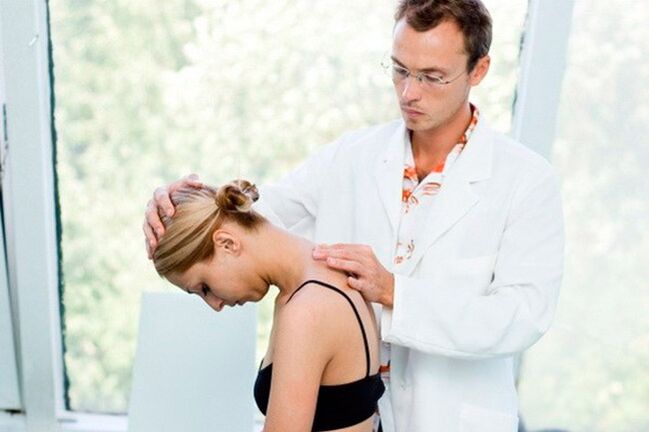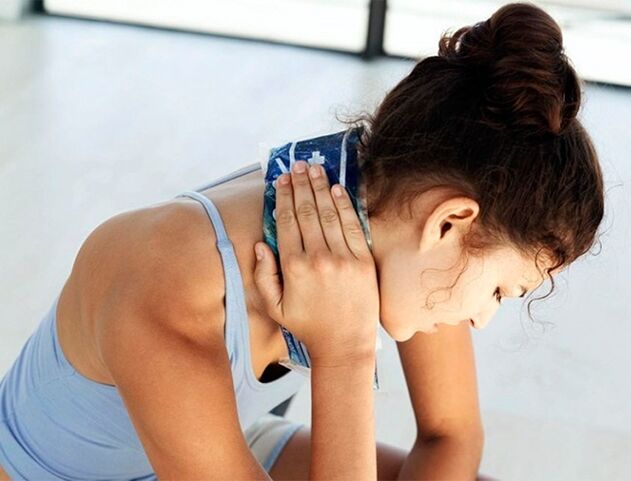Cervical osteochondrosis is a pathology associated with degenerative changes in cartilage tissue and intervertebral discs.

The pathology occurs due to intense stress, poor lifestyle and many other factors.According to records, osteochondrosis occurs in 30-40 years old, but the age of onset is getting younger year by year.Nowadays, the disease also occurs in adolescence.
Causes of Cervical Spine Chondrosis
As rickets progress, the vertebral tissue becomes affected, causing severe pain and discomfort when moving.Most often, pathological phenomena occur due to overloading of problem areas.But rickets often develop due to unstable emotional states and frequent stress.
What causes the disease to develop:
- Inactive lifestyle.
- Stay in the same position for a long time.
- Slept on the wrong mattress.
- Intense physical activity.
- Physical labor.
- Injury to problem areas.
- flatfoot.
- Age-related body changes.
- Poor posture, scoliosis.
- Metabolism is impaired, interfering with the normal absorption of beneficial elements in the body.
- Wearing inappropriate shoes.
- Lack of vitamins in the body.
- Malnutrition, dehydration.
Bad lifestyle habits can also influence the development of cervical rickets and their unpleasant symptoms.
Symptoms of cervical osteochondrosis
The first main symptoms that appear when the pathology occurs are pain in the neck, back and shoulders.Patients may experience heaviness, pulsation, numbness, and goosebumps in the problem area.The pain may change its nature from acute to painful.The presence of other symptoms depends on the stage of rickets.
As the disease progresses, patients may experience fatigue and tight neck and shoulder muscles.Discomfort is not only felt in the affected area, the pain can also radiate to the chest, waist and arms.The pain syndrome impairs mobility of the upper limbs, causing breathing difficulties, and patients often experience shortness of breath.
In addition to discomfort, a person's blood circulation is impaired and blood vessel function deteriorates, causing swelling and redness of the skin.
What are the symptoms associated with cervical osteochondrosis:
- Neck, shoulder, back pain.
- Discomfort when moving or exercising.Feeling of muscle stiffness and heaviness in problem areas in the morning.
- Pins and needles and numbness in problem areas.
- Muscle tension, cramps, and spasms.
- The pain and crushing headache did not go away despite taking painkillers.
- Nausea, dark eyes, and drowsiness.
- Chest pain.It may feel like heartache.
- Impaired mobility of upper limbs.
With cervical chondrosis, pain often radiates to the scapula and shoulder area.As the condition progresses, patients may develop headaches and visual disturbances.These symptoms indicate that the pathology has reached a more severe stage.
How dangerous is this disease?

Cervical osteochondrosis is a serious disease that can cause frequent loss of consciousness, hypertension, and vegetative vascular dystonia.Additionally, the pathology increases the chances of heart attack and stroke.Cervical chondrosis can lead to kidney, liver, and gastrointestinal disease.
The disease also has an important impact on reproductive function.Osteochondrosis can cause infertility and impotence.As the pathology progresses, a person experiences apathy, frequent pain, decreased performance and interest in life.This directly leads to the development of depression.
Treatment of Cervical Spine Chondrosis
Osteochondrosis can be treated with medications, traditional methods, and physical therapy procedures.Specific treatment methods are formulated by doctors based on the progression of the disease.
drug treatment
Medications are only prescribed in the later stages of the disease, when the patient experiences unbearable pain and discomfort while moving.
The purpose of treating the pathology with drugs is to eliminate the inflammatory process and relieve pain.Medications are given in the form of injections and oral administration.
What are the functions of drugs:
- Relieve pain and muscle tension.
- I block the inflammatory process.
- Normalizes blood circulation and vascular function.
- Promote the repair of cartilage tissue.
- Restore mobility.
- Alleviate moral pressure
During treatment, nonsteroidal medications are used to relieve pain and anti-inflammatory ointments are used to help reduce swelling.Additionally, intravenous injections are used.
Muscle relaxants are used to dilate blood vessels and relieve muscle tension.Calming products help overcome apathy, drowsiness and paranoia.Antidepressants and sleeping pills are used for this.
traditional medicine
Traditional methods help eliminate early symptoms of rickets.Herbal teas are used to relieve swelling and pain.Not only do they remove physical discomfort, they also remove moral stress.
A similar drink is used internally; the dried leaves of the following plants are suitable for preparation:
- Chamomile.
- raspberry.
- Mint.
- Rose hips.
Herbal tea has a positive effect on gastric function and does not cause side effects.You can drink up to 3 cups of decoction per day.It must be left for several hours before use.
Therapeutic infusions help normalize circulation, restore mobility, and eliminate numbness in the skin.Pine buds have beneficial effects on the body.
Pharmaceutical methods:
- Add 1 cup of washed buds to an equal amount of sugar and mix.
- Pour the resulting mixture into a glass of water and let soak for 2 weeks.
Take one spoonful of the solution daily before or after meals.Herbal decoctions can restore physical movement and relieve mental stress.
Product making method:
- Add a handful of dried dandelion root to a cup of water.
- The resulting solution was heated in a water bath and left in the dark for 1 hour.
- Strain the broth and take half a cup daily.
It is worth noting that Chinese medicinal infusions are not recommended to be stored for more than 4 days.After this period, they lose their beneficial properties and cause adverse reactions.
Physical therapy, massage, exercise therapy
Therapeutic exercise and massage are effective ways to eliminate swelling, pain, and discomfort in your neck.All exercises and activities must be performed under a doctor's supervision, and patients must follow all recommendations to prevent complications.
Perform gymnastics 3 hours after meals; exercise before bed is not recommended.The doctor chooses the exact set of exercises based on the diagnosis.
Magnetic therapy, acupuncture, and electrophoresis can help restore spinal flexibility and eliminate pain.If necessary, such methods are prescribed by a doctor.
Precautions
To prevent the development of osteochondrosis, you must adhere to the following rules:
- Maintain a regular routine and get enough sleep.
- Allocate physical activity wisely: Don't overexert yourself, but don't lead an inactive lifestyle either.
- Choose shoes that fit well and are comfortable.For flat feet, use special models.
- Sleep on an orthopedic mattress.
- Eat right and avoid unhealthy foods.
- Break free from harmful addictive behaviors.
- Exercise all muscle groups with simple physical exercises every day.
- If you experience discomfort in your shoulders and neck, you can massage yourself and rub your skin with special ointment.
- If you suspect osteochondrosis, consult your doctor immediately for a thorough physical diagnosis.
To prevent pathological changes, it is also necessary to restore the emotional state and eliminate the stress of life.
Osteochondrosis is a serious disease that can lead to irreversible consequences.By remaining vigilant about your health and prompt diagnosis, you will be able to avoid unpleasant complications and return your body to its normal state.


























